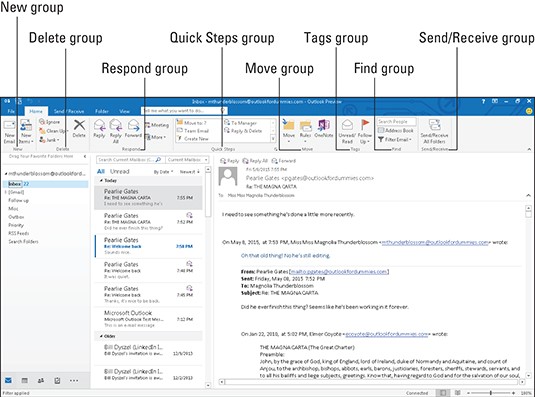- Adjust columns and panes. The columns in the Inbox and other mail locations are adjustable. To widen a column, position the mouse pointer between two column headings and drag to change the width of the one on the left. You can also adjust the relative sizes of the navigation pane, mail list, and reading panes; just position the mouse pointer over a divider between the panes and drag.
- Choose which columns appear. You can customize the columns that appear in your mail folders. On the View tab, click Add Columns to access the Show Columns dialog box, and add or remove columns from there.
- Open a message in its own window. Reading a message in the Reading pane is good sometimes, but other times you might want to see the message in a larger space. Double-click a message to open it in a new window, or select it and then on the View tab, click Open in New Window.
- Close all open items. Here’s a shortcut when you have a lot of different messages or other items open at once. To close them all in one swoop, on the View tab click Close All Items.
- Group messages by conversation. If there has been a lot of back-and-forth messages on a topic, you can easily see all the related messages at once. On the View tab, select the Show as Conversations check box and click This Folder. Then use the Conversations Settings button’s drop-down menu to fine-tune how the conversation threads appear.
- Access advanced viewing settings. There are more ways to adjust the Mail module’s view than you have probably imagined. To access them, from the View tab, open the Arrangement group’s gallery and choose View Settings on its menu. The Advanced View Settings dialog box opens. From here you can access columns, groups, sorting filtering, conditional formatting, and more.
- Select favorite folders. To make a folder shortcut appear in the Favorites area at the top of the navigation pane in the Mail module, drag-and-drop it there from the bottom portion of the navigation pane. You can also right-click a folder and choose Show in Favorites.
- Filter email. Have you ever tried to browse your Inbox looking for messages of a certain flag or category, or that have attachments? On the Home tab you can click Filter Email and then choose a criterion by which to quickly filter. For example, choosing Attachments shows only messages that contain attachments. You can also filter by typing a search word or phrase in the Search Current Mailbox box above the mail list.
- Respond to requests for delivery or read receipts. Some messages come with a request for an acknowledgement that you have received or read them. Some people find this useful; others think it’s intrusive or rude. You can set your preferences as to what will happen when you get such a request. Choose File, Options, click Mail, and scroll down to the Tracking section. In the For Any Message Received That Includes a Read Receipt Request section, choose your preference: Always send a read receipt, never send one, or ask each time.
- Use stationery. The Stationery feature in Outlook isn’t great for business, because it adds unnecessary graphics to the message and most business people consider it unprofessional. But for personal use it can add a fun, whimsical touch. Choose File, Options, and click Mail. Click Stationery & Fonts, and then set up your stationery in the Signatures and Stationery dialog box. Try clicking the Theme button to start out with a theme. After setting up your theme, when composing a new message, make sure that HTML is selected on the Format Text tab, because stationery works only with HTML-formatted messages.







